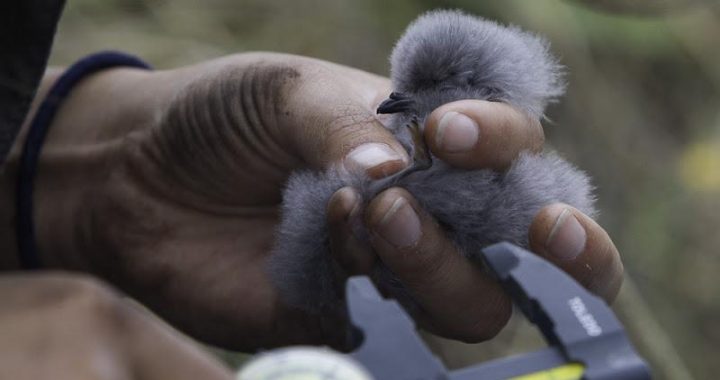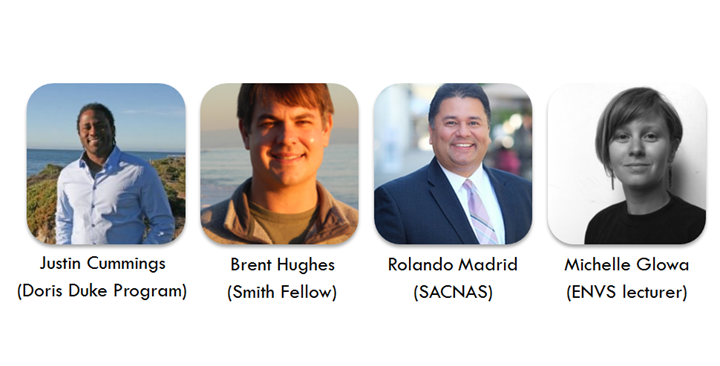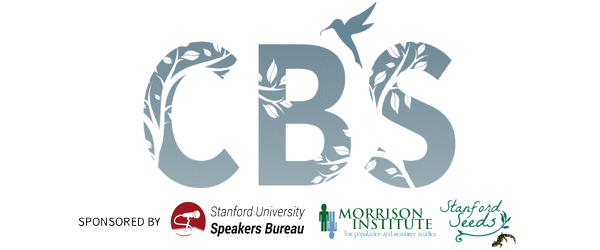I’m excited t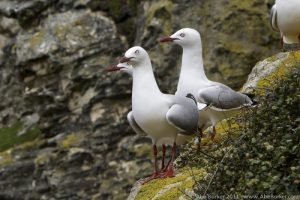 o kickoff the SCSCB community blog and rather than bore you with something new, I’ll share something I wrote on a 2012 expedition to the Mokohinau Islands in New Zealand during some inclement weather. Hopefully it grants a window into the occasionally exciting day in the life of a seabird biologist. You can keep up with Abe’s research and adventures at www.NeverStopNerding.Com
o kickoff the SCSCB community blog and rather than bore you with something new, I’ll share something I wrote on a 2012 expedition to the Mokohinau Islands in New Zealand during some inclement weather. Hopefully it grants a window into the occasionally exciting day in the life of a seabird biologist. You can keep up with Abe’s research and adventures at www.NeverStopNerding.Com
All six of the island’s mammals are just keeping dry today, poorly adapted to island life, maybe we’re not meant to be here… The thousands  of avian and reptilian vertebrate residents are probably just as happy to have drenching rain and 30 knot gusts as calm sunshine, but it tends to throw a slight kink into our well oiled seabird research machine. Last night we checked the radar maps to see a large red/pink (meaning hellish) blob of weather headed our way. To affirm our tough reputation as seabird biologists, we spent a few hours in the rain looking for storm-petrel burrows, and looking for petrels but before long we were thoroughly drenched and our fearless leader Chris declared that the following day would be a “Scones Day”, one bit of kiwi English that needed no translation. Be it offshore i
of avian and reptilian vertebrate residents are probably just as happy to have drenching rain and 30 knot gusts as calm sunshine, but it tends to throw a slight kink into our well oiled seabird research machine. Last night we checked the radar maps to see a large red/pink (meaning hellish) blob of weather headed our way. To affirm our tough reputation as seabird biologists, we spent a few hours in the rain looking for storm-petrel burrows, and looking for petrels but before long we were thoroughly drenched and our fearless leader Chris declared that the following day would be a “Scones Day”, one bit of kiwi English that needed no translation. Be it offshore i slands in California or New Zealand, days like this aren’t fit for much other than baking, staying indoors, editing photos and writing. With any luck the storm should blow over by the end of today, leaving us with a few nice days for the rest of our trip.
slands in California or New Zealand, days like this aren’t fit for much other than baking, staying indoors, editing photos and writing. With any luck the storm should blow over by the end of today, leaving us with a few nice days for the rest of our trip.
If I look around the bunkhouse, or “bach”, I could be on almost any island’s research station. There are walls littered with various old maps, photos and biological curiosities; a pile of seabird carcasses by the door, many more spread wings and feathers in the entranceway, dilapidated furniture, more ba ttery chargers than I can count, and importantly lots and lots of high calorie foods. While indoors, it can look a lot like the Farallones, outside at night presents a far different seabird soundscape. Just down the lighthouse path are Fluttering and Little Shearwater burrows deep in the vegetation, and if one walks a little farther, White-faced Storm-Petrels and Black Winged Petrels have turned the ground into swiss cheese. Hobbling around the ground like bizarro Cassin’s Auklets are Common Diving-petrels, and you must be super careful not to accidently step on the grass tussocks that seem alive with calls. There are a few burrows you could lose a leg in, and those belong to the Grey Faced Petrels I’m yet to see, but maybe I can find my vagrant friend from Monterey Bay one of these nights. Lastly, while confined to the lower slopes, I’d be a fool to forget the foul smelling, foul sounding Blue Penguins. A real good Kiwi seabird biologist already could tell you where I am by species assemblage, but for the rest; we’re camped out on Burgess Island in the Mokohinau Islands.
ttery chargers than I can count, and importantly lots and lots of high calorie foods. While indoors, it can look a lot like the Farallones, outside at night presents a far different seabird soundscape. Just down the lighthouse path are Fluttering and Little Shearwater burrows deep in the vegetation, and if one walks a little farther, White-faced Storm-Petrels and Black Winged Petrels have turned the ground into swiss cheese. Hobbling around the ground like bizarro Cassin’s Auklets are Common Diving-petrels, and you must be super careful not to accidently step on the grass tussocks that seem alive with calls. There are a few burrows you could lose a leg in, and those belong to the Grey Faced Petrels I’m yet to see, but maybe I can find my vagrant friend from Monterey Bay one of these nights. Lastly, while confined to the lower slopes, I’d be a fool to forget the foul smelling, foul sounding Blue Penguins. A real good Kiwi seabird biologist already could tell you where I am by species assemblage, but for the rest; we’re camped out on Burgess Island in the Mokohinau Islands.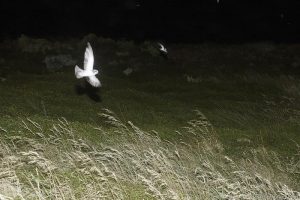
Why am I here? If you’re interested in protecting threatened seabirds, New Zealand is the place to be. Despite it being smaller in area than California, it has over 30 threatened breeding species. Evaluating the population trends, and evaluating the outcomes of conservation actions here is important to saving these species. In fact, some of the most cost-effective actions to protect seabirds in our local marine environment depend on protecting breeding habitat halfway around the world. Thankfully New Zealanders have led the way in island scale restoration, Burgess Island was one of the first islands in New Zealand to have it’s rodents removed by the Dep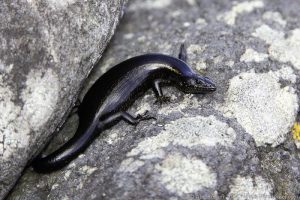 artment of Conservation in 1990, and the island now thrives, rodent free for over a quarter century. Today these islands support at least 12 breeding species of seabirds (including 7 procellarids!), endemic skinks, geckos and surely even more invertebrate and plant biodiversity than us bird-centric folks give credit to.
artment of Conservation in 1990, and the island now thrives, rodent free for over a quarter century. Today these islands support at least 12 breeding species of seabirds (including 7 procellarids!), endemic skinks, geckos and surely even more invertebrate and plant biodiversity than us bird-centric folks give credit to.
I’m here with five other scientists to investigate how seabirds are faring out here, where they go and what they do. My own interest is tes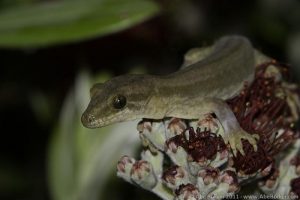 ting acoustic monitoring approaches to measure the diversity and abundance of these remote colonies. The nights out here are overwhelming as tens of thousands of birds descend and release all sorts of primitive sounds into the night. By contrast, even at the species rich Farallones, nighttime acoustic activity is generally restricted to four or five species of seabirds, while recordings here might have twice as many species vocalizing over the course of a single night. Both are a far cry from the single species tern colonies I started working in three yea
ting acoustic monitoring approaches to measure the diversity and abundance of these remote colonies. The nights out here are overwhelming as tens of thousands of birds descend and release all sorts of primitive sounds into the night. By contrast, even at the species rich Farallones, nighttime acoustic activity is generally restricted to four or five species of seabirds, while recordings here might have twice as many species vocalizing over the course of a single night. Both are a far cry from the single species tern colonies I started working in three yea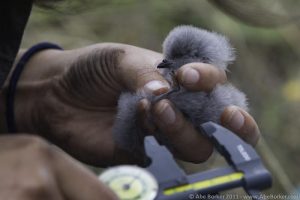 rs ago! Why research the effectiveness of acoustic monitoring out here? For every accessible island like Burgess, there are many more so remote, fragile or dangerous to visit that we don’t know much about the island’s seabirds. Even on Burgess, we work in only a fraction of the seabird breeding habitat for a few months a year. Island scale information on the diversity and abundance of cryptic seabirds, is critical to evaluating conservation actions and management. In a country like New Zealand with so many endangered seabirds, and relatively few people and resources, there’s a strong desire to embrace scalable tools for population monitoring like acoustics.
rs ago! Why research the effectiveness of acoustic monitoring out here? For every accessible island like Burgess, there are many more so remote, fragile or dangerous to visit that we don’t know much about the island’s seabirds. Even on Burgess, we work in only a fraction of the seabird breeding habitat for a few months a year. Island scale information on the diversity and abundance of cryptic seabirds, is critical to evaluating conservation actions and management. In a country like New Zealand with so many endangered seabirds, and relatively few people and resources, there’s a strong desire to embrace scalable tools for population monitoring like acoustics.
The trip out here was simple enough, a 3 hour ride out here 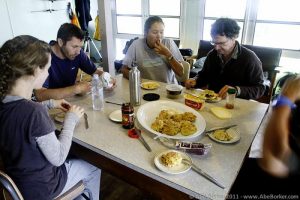 through lumpy seas and windy weather, huddled behind the cabin, staying moderately dry, with an occasional glimpse of a prion or shearwater through the boat spray. After unloading what seemed like a mountain of gear with two dinghies, and seeing off the five biologists hopping off the island, we set about our work. The first chore was getting everything from the beach to the “bach” (bunkhouse) about 305 vertical feet above us on the tippy top of Burgess Island. After a couple of exhausting trips up and down,we settled in and unpacked human fuel (food), island fuel (petrol), and field gear. We were just in time to watch the air force practice
through lumpy seas and windy weather, huddled behind the cabin, staying moderately dry, with an occasional glimpse of a prion or shearwater through the boat spray. After unloading what seemed like a mountain of gear with two dinghies, and seeing off the five biologists hopping off the island, we set about our work. The first chore was getting everything from the beach to the “bach” (bunkhouse) about 305 vertical feet above us on the tippy top of Burgess Island. After a couple of exhausting trips up and down,we settled in and unpacked human fuel (food), island fuel (petrol), and field gear. We were just in time to watch the air force practice 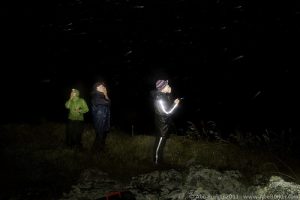 a supply drop (just some practice for them). One package of lemonade ended up “in the drink”. Thankfully the package with beer and rocky road settled in just a few meters from the precipice. I got to tour the north headland looking for the lost supply package, but we reckon it’s a goner.
a supply drop (just some practice for them). One package of lemonade ended up “in the drink”. Thankfully the package with beer and rocky road settled in just a few meters from the precipice. I got to tour the north headland looking for the lost supply package, but we reckon it’s a goner.
When I returned Derek had already fixed up dinner, mince meat and sautéed veggies. Well fed we were ready to check out the night time visitors. One step out the door and we heard could hear petrels 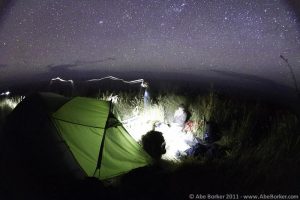 calling overhead, and after walking a few hundred meters we already encountered five species of tubenoses! Black-winged Petrels and White-faced Storm-petrels buzzed our heads as we stood on the ridge. My colleagues began “War-whooping”, an improbable but incredibly effective solution to getting a wild bird to land squarely at your feet. It was an incredible introduction to the island, and I slept well, fully “knackered” from the trips up and down from the beach. That night I’d like to say I dreamed of what other birds the island would hold ov
calling overhead, and after walking a few hundred meters we already encountered five species of tubenoses! Black-winged Petrels and White-faced Storm-petrels buzzed our heads as we stood on the ridge. My colleagues began “War-whooping”, an improbable but incredibly effective solution to getting a wild bird to land squarely at your feet. It was an incredible introduction to the island, and I slept well, fully “knackered” from the trips up and down from the beach. That night I’d like to say I dreamed of what other birds the island would hold ov er the next week, perhaps the elusive New Zealand Storm-petrel, but I was probably out like a light on a healthy portion of air dropped rocky road and Heineken courtesy of the New Zealand Air Force.
er the next week, perhaps the elusive New Zealand Storm-petrel, but I was probably out like a light on a healthy portion of air dropped rocky road and Heineken courtesy of the New Zealand Air Force.
-Abe Borker
